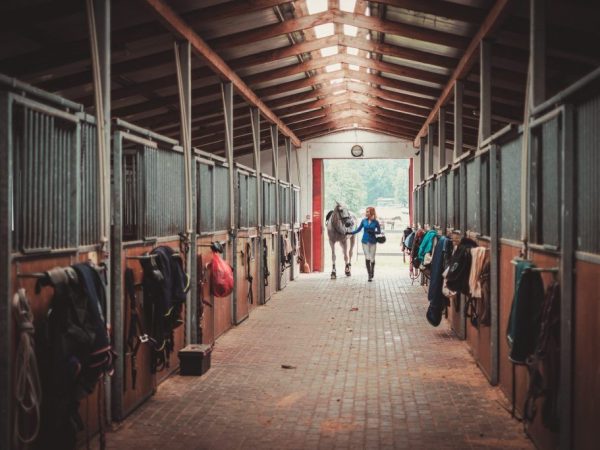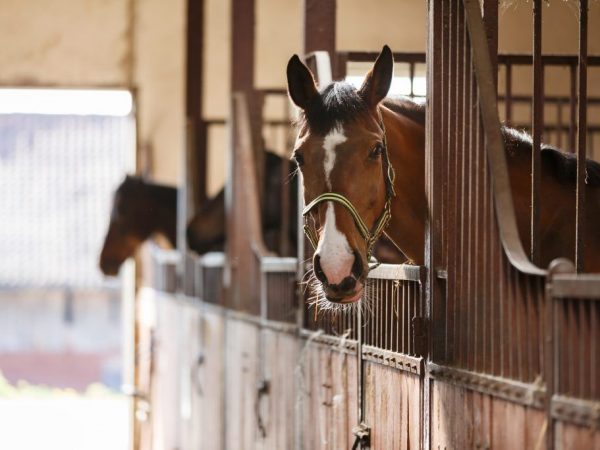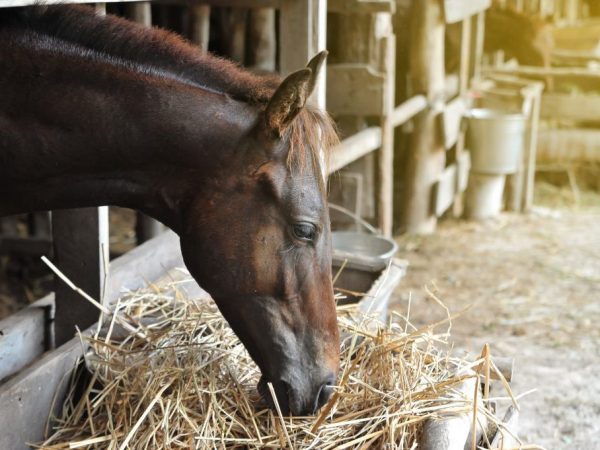How to build a horse stall correctly
Arrangement of a comfortable stall plays an important role in keeping horses. It also promotes discipline and order in nervous animals. The box for the horse should be large enough to feel comfortable.

Horse stall construction
Before proceeding with the construction, it is recommended to thoroughly study the features of the premises and the requirements for it. It is important to choose the right materials and method (scheme) of construction.
Types of horse stalls
Before you build a horse stall, you need to decide which type of buildings will be appropriate for a particular farm. There are several types of stalls, each of them has its own advantages and disadvantages:
- Stationary stalls are the most common. They are used for keeping animals in stable conditions. Partitions are made of brick, wood or metal. The front wall of the stall is also a door.
- Mobile stalls are used to keep horses away from home in competitions. Their plus is that they are quickly mounted and just as quickly removed if necessary. The walls are most often made of plastic or lightweight metal structures.
- Denikas-transformers differ from others in a special structure. The walls have a hinged device in order to facilitate cleaning in a stable or to combine 2 or more stalls into one. For this, the walls are simply pushed back. There are also telescopic partitions. With their help, you can increase the stall area if necessary.
Horse stall requirements
The dennik is a place for loosely keeping horses to protect them from adverse weather conditions, external stimuli, as well as to correct acquired behavioral reflexes.
The first and main requirement for the room is warmth, dryness and no drafts. This is especially true for valuable broodstock, mares with calves and young animals in training.

The room should be warm, dry and free of drafts.
When building a stall, it is important to remember:
- When choosing a place to build, you should take care of groundwater. If they are close to the ground, then the stall will be damp even in the hottest summer. To avoid this, stables are built on a hill or artificial drainage is arranged to drain groundwater.
- The standard for horse paddocks is 3 x 3 m, or 9 m², but most often this is not enough, especially if the animal is large or it is a female with a foal. Stiffness of movement provokes the horse to kick with his hoof, throw and overturn the feeders. An ideal room is at least 4 x 4 m in size. There the horse can lie down or turn around without hindrance.
- Ceilings should be as high as possible: this contributes to good ventilation of the room and free air circulation in it. The height should be at least 3 m. This height excludes injury to the horse if it rears up from fright. In addition, the wiring and lighting will be high enough to keep curious animals out of the way.
- It is necessary to take care of the insulation of the stables, especially in regions with very cold winters. For this, building insulation or double walls are used. The outer wall is made of bricks, concrete or timber, and the inner wall is made of planks. The distance between them is at least 15 cm. This gap is filled with sand or expanded clay. If it is not possible to insulate the room, additional steam or electric heating will be required.
Walls
Most often, one or even two walls are shared with the stables. The rest are made in the form of partitions to restrict horses' access to other animals and household equipment.
The best option would be to install structures that are easy to dismantle. This is useful if you need to repair or replace individual parts, as well as when cleaning and disinfecting your stables. The problem is that animals often gnaw and break the septum with their hooves. For this reason, many people make the side walls of the stall from brick in one layer.
Horses are herd animals, and they need contact with their relatives. In order not to restrict the horses in communication, the walls of the stall are made not deaf: lattice partitions are installed at a height of 140-160 cm above the floor.

Horses need contact with their relatives
The front wall is also a door and a place for attaching the feeder, nursery and drinker. If the size of the stall does not allow them to be placed on another wall, so that it is convenient to feed and pour in fresh water, horses from boredom can spill water and turn out the feed.
The front partition or door is made of wood or lattice, as well as combinations thereof. In stables, where visitors often visit, stalls are equipped with a high lattice frontal partition so that the horse cannot reach the person and bite him. In private backyards, you can equip a more open type of front wall.
Metal structures must be specially coated to prevent corrosion. It is important that this spray is not toxic to animals.
Floors
The floors in the stable are sloped so that the slurry can easily flow into the gutters provided for this. But you need to seriously think about the choice of material for the floor. It is usually made from the following materials:
- In the old days, the floors of the stables were made of adobe. This coating was very warm and did not slip from the slurry. Due to its moisture-repellent properties, the clay did not absorb horse urine and feces. The adobe floor was easy to clean, but the clay had to be replaced after a while. Now the arrangement of such a floor is a very problematic matter if there is no clay quarry nearby.
- Floors can also be covered with wooden planks, but this is the least practical method. The tree absorbs moisture and swells from this. Constant contact with slurry leads to early rotting of the coating. A wooden floor can cause injury to animals in a stable due to heavy hooves sliding over it.
- The best option, both economically and practically, is a concrete floor. It is durable and easy to disinfect. Concrete does not tend to absorb moisture, and it also perfectly protects the stable from the penetration of mice and rats. The only drawback is that the floors get very cold during the winter, so you should prepare the litter straw for the cold season.
- In recent years, in private stables, specialized flooring in the form of rubberized rugs has become often used. They can be solid or multi-piece, which are assembled like a puzzle. They are laid on a soft base: sand or sawdust. Thanks to such a covering, it is easy to clean the stalls, and the mats themselves can be washed and disinfected. Some even have special antifungal sprays in their composition.A significant disadvantage of rubberized flooring is its high cost.
Stall arrangement
Feeders and drinkers are located at a height of 60-70 cm above the ground, so that it is convenient for the animals to eat and drink from them. They must be made of non-toxic materials and meet the following requirements:
- Have rounded edges to avoid injury and cuts.
- Have a smooth surface with no gaps so that food does not get clogged there, thereby provoking the formation of mold.
- The depth of the feeders should be at least 25-30 cm so that the food does not spill out from there while eating.

Feeders must be made of non-toxic materials
Wooden feeders are rarely used due to their impracticality, since horses quickly gnaw them, and disinfection causes a lot of inconvenience. For the manufacture of feeders, durable plastic, baked clay or galvanized containers are used.
Since the main component of the horse's diet is the village or fresh grass, the feeder plays a secondary role in feeding the animals. Those farmers who throw hay right on the floor of the stall are faced with a large overconsumption of feed: the horses simply trample it. This is why making a nursery is a great solution to this problem. A wooden or metal grate is attached to the door of the stall, behind which hay or straw is laid.
Conclusion
The main thing in the construction of a stall for horses is that the animals should be comfortable and comfortable in it. It is necessary to protect horses from drafts and dampness, especially for foal mares, foals, young animals in training and valuable breeding stock.
Sometimes very cramped stalls with low ceilings are built. In them, the horse cannot turn around or fully lie down. The use of such facilities is appropriate for disciplinary punishment for violent individuals, but not suitable for the permanent housing of animals.


